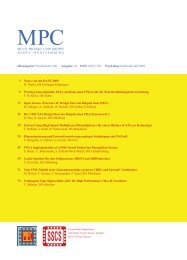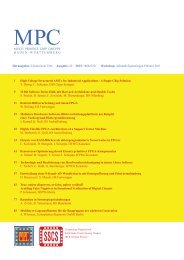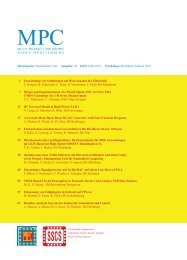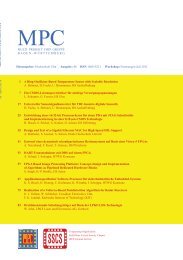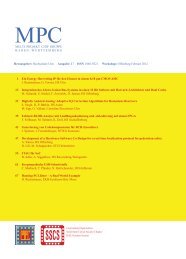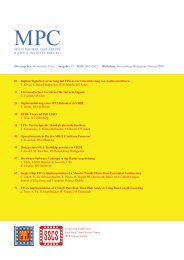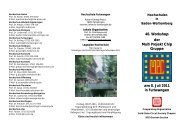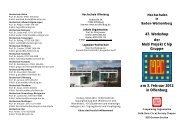[Geben Sie hier die Überschrift ein] - MPC
[Geben Sie hier die Überschrift ein] - MPC
[Geben Sie hier die Überschrift ein] - MPC
- TAGS
- mpc.belwue.de
Sie wollen auch ein ePaper? Erhöhen Sie die Reichweite Ihrer Titel.
YUMPU macht aus Druck-PDFs automatisch weboptimierte ePaper, die Google liebt.
<strong>MPC</strong>-WORKSHOP JULI 2012<br />
Figure 4: Model to calculate coupling factor between reader<br />
and tag antenna, both aligned.<br />
The high power part consists of a power rectifier and<br />
a LDO regulator, both get activated when enough RF<br />
energy is available. The LDO provides V_Out, which<br />
can be adjusted by an external feedback resistor divider<br />
(not shown), connected to the analog input FB<br />
(feedback).<br />
The antenna inputs are directly connected to the over<br />
voltage protection circuit. This circuit is very critical<br />
because there are absolute limits for the voltage at the<br />
pads defined by the technology (breakdown voltages<br />
of the gates, about 3.6 V for the referenced technology).<br />
This circuit shall not be active under normal operation;<br />
it is only used in case of overvoltage input,<br />
which may happen because of the undamped resonance<br />
of the antenna, if the load at the output is<br />
switched off unintentionally.<br />
The communication part consists of the passive rectifier,<br />
low pass filter, Schmitt-trigger, high pass filter,<br />
comparator and modulator. For clock recovery a RS<br />
flip flop is used. The circuit blocks are further described<br />
later in detail.<br />
III. PROTECTION CIRCUIT<br />
The protection circuit consists of the ESD protection<br />
of the pad cells (library) and additional circuits. The<br />
operation of a transponder in the magnetic field depends<br />
mainly upon two factors which are,<br />
• Coupling factor (K)<br />
• Quality factor (Q)<br />
The coupling factor between the reader antenna and<br />
the tag antenna depends on geometrical parameters as<br />
shown in figure 4. The coupling factor K can be calculated<br />
by equation 1,<br />
µ 0π<br />
⋅ N1N<br />
K(<br />
d)<br />
=<br />
2 L . L<br />
1<br />
2<br />
2<br />
⋅<br />
2<br />
B<br />
2<br />
B<br />
r<br />
r<br />
⋅ r<br />
2<br />
T<br />
2<br />
+ d<br />
(1)<br />
Figure 5: Overvoltage protection circuit.<br />
Equation 1 shows that the coupling factor K depends<br />
on the antenna diameter of the reader rB and tag rT as<br />
well as the distance d in between them. Normally the<br />
value of K varies from 0.01 to 0.1. The higher the<br />
coupling factor is, the stronger is the field. The tag has<br />
to operate from field strength of 150 mA/m to 5 A/m,<br />
with 8 A/m maximum sustainable field strength (ISO<br />
15693). This is not a problem, if the energy is consumed<br />
by a load.<br />
Resonance of the antenna leads to an increase in<br />
amplitude at the input pins which is proportional to the<br />
quality factor (figure of merit) Q of the inductance/capacitance/load-circuit.<br />
The quality factor Q is given by the relationship<br />
RL<br />
Q =<br />
2πf ⋅ L<br />
(2)<br />
2<br />
where RL is the equivalent load resistance of the transponder<br />
and L is the equivalent inductance of the<br />
transponder antenna. The read range increases with<br />
the Q of the antenna. It is recommended to be adjusted<br />
to ca. Q = 15 for good sensitivity. The voltage is directly<br />
proportional to the Q factor of the circuit [5].<br />
Figure 5 shows the protection circuit. There are three<br />
stages of staggered transistors. The input voltage is<br />
divided by a resistive divider, providing the gate voltages<br />
for each stage. It is designed in such a way so<br />
that when the voltage on the antenna is beyond the<br />
maximum allowed limit, the transistors will switch on<br />
and hence draw power from the input, so the antenna<br />
is damped and the input voltage clamped to a safe<br />
value below the critical breakdown voltage of the<br />
transistors (ca. 3.7 V).<br />
To protect the rest of the circuit, these transistors<br />
must be able to carry milliamps of current. To distribute<br />
the voltage load, the clamp transistors are placed<br />
in separate wells, so each transistor carries only a third<br />
of the input voltage. The switching thresholds are<br />
taken from a voltage divider, which is supplied by the<br />
power rectifier.<br />
27


![[Geben Sie hier die Überschrift ein] - MPC](https://img.yumpu.com/8654082/30/500x640/geben-sie-hier-die-uberschrift-ein-mpc.jpg)
